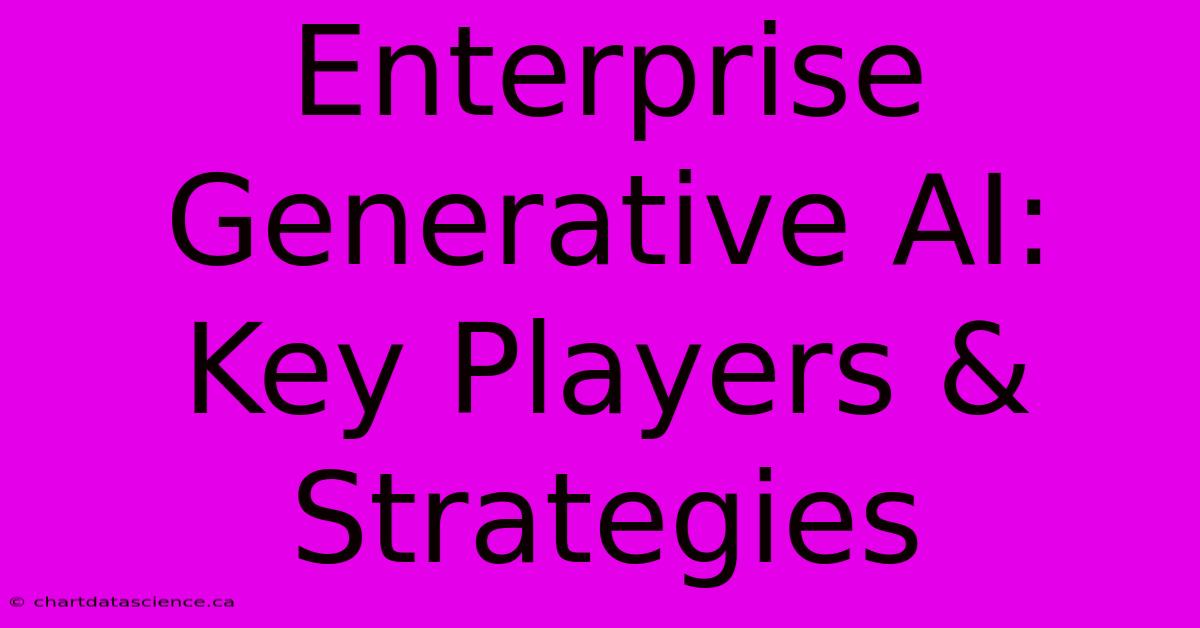Enterprise Generative AI: Key Players & Strategies

Discover more detailed and exciting information on our website. Click the link below to start your adventure: Visit My Website. Don't miss out!
Table of Contents
Enterprise Generative AI: Key Players & Strategies
Generative AI is changing the game, especially for businesses. You've probably heard the buzz about AI creating realistic images, writing compelling copy, and even composing music. But did you know this technology is being used by big companies to solve real-world problems? That's right, enterprise generative AI is exploding and it's time to get in the know.
What is Enterprise Generative AI?
Think of it like this: Enterprise Generative AI is like a superpowered toolbox for businesses. It uses machine learning to create new content, automate tasks, and make smarter decisions. We're talking about AI that can generate product descriptions, write code, design new products, and even personalize customer experiences.
Key Players in the Game
The generative AI landscape is crowded, but these players are leading the pack:
- OpenAI: You probably know them for their popular tool, ChatGPT. But OpenAI offers a range of generative AI models, including DALL-E for image generation and Codex for code generation.
- Google: Google AI is no slouch, with models like LaMDA for conversational AI and Imagen for image generation. They're also heavily investing in research and development.
- Microsoft: Microsoft has partnered with OpenAI and is integrating generative AI into their products, including Azure OpenAI Service.
- NVIDIA: They're the powerhouse behind many AI platforms and offer their own generative AI models.
- Hugging Face: This company is a hub for open-source AI models, including many generative AI models.
Strategies for Success
So, how can businesses get in on the generative AI action? Here's a sneak peek at some winning strategies:
1. Identify Use Cases: Don't just jump on the bandwagon. Figure out what generative AI can do for your specific business. Think about tasks that can be automated, improved, or completely reimagined.
2. Build a Strong Data Foundation: Generative AI thrives on good data. Make sure you have a clean, organized, and relevant data set. You'll need this to train and fine-tune your AI models.
3. Start Small, Scale Up: Don't go all-in right away. Test out generative AI in small, controlled environments. Then, once you see the results, you can scale your implementation.
4. Consider the Ethics: Generative AI raises ethical questions. Make sure you're using this technology responsibly. Think about things like bias, transparency, and data privacy.
5. Don't Be Afraid to Get Creative: This is the fun part! Explore different ways to use generative AI. Maybe you can create new products, design better marketing campaigns, or even automate your customer service.
The Future is Generative
Generative AI is a game-changer, and it's only going to get bigger. Whether you're a small business or a giant corporation, it's time to get involved. Think outside the box, experiment, and watch how generative AI revolutionizes your business.

Thank you for visiting our website wich cover about Enterprise Generative AI: Key Players & Strategies. We hope the information provided has been useful to you. Feel free to contact us if you have any questions or need further assistance. See you next time and dont miss to bookmark.
Also read the following articles
| Article Title | Date |
|---|---|
| Man City Vs Southampton Premier League Live Stream | Oct 26, 2024 |
| All Blacks Facing Pressure From Jones | Oct 26, 2024 |
| Proton E Mas 7 Bookings Open Rm 120k | Oct 26, 2024 |
| Israel Strikes Iran Military Targets In Three Waves | Oct 26, 2024 |
| Where To Watch Real Madrid Vs Barcelona La Liga | Oct 26, 2024 |
